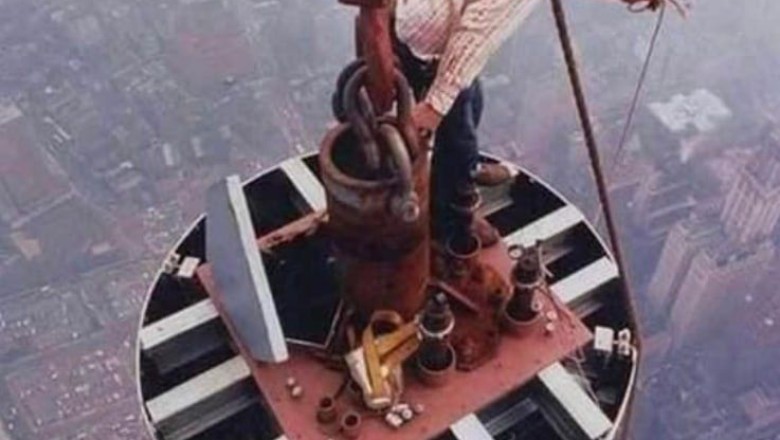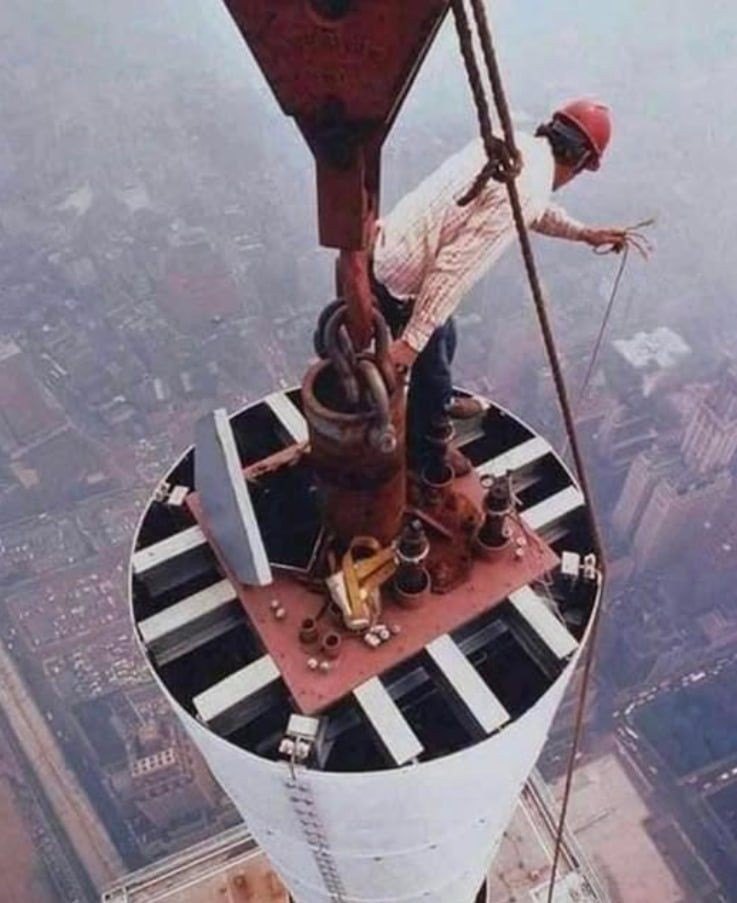
The Untold Stories of the World Trade Center: A Glimpse into the Lives of Skyline Guardians

In 1979, a captivating photograph emerged, capturing not just a moment, but a testament to human ingenuity and courage atop one of the world’s most iconic structures: the World Trade Center. The image, taken by renowned photographer Peter Kaplan, features a lone worker meticulously repairing an antenna high above the bustling streets of New York City. This scene isn’t merely a snapshot; it encapsulates the scale of the twin towers, the risks involved in maintaining such monumental edifices, and the integral role technology played in the fabric of daily life during that era.
The World Trade Center: A Symbol of Ambition
When completed in the early 1970s, the World Trade Center stood as the tallest building in the world. Rising to a height of 1,368 feet, the twin towers redefined the Manhattan skyline and symbolized the bold aspirations of post-war America. They were not just architectural marvels but also beacons of economic power, reflecting the nation's ambition to establish itself as a global leader in trade and finance.
As the ‘70s progressed, the structures became emblematic of technological advancement, housing advanced communication systems essential for transmitting television and radio signals. The towering antenna that the worker was repairing in Kaplan’s photograph was a critical component of this functionality. It enabled the seamless connection of communication technologies that would soon become a staple of American life. Yet, amid this awe-inspiring technological landscape, the image captures not just innovation but the human element crucial to its success.
A Worker’s Responsibility: High Above the Ground
The photograph also tells a story that many overlook. While the World Trade Center’s grandeur is often celebrated, the everyday reality of those who worked to maintain its functionality remains largely untold. As the worker adjusts the antenna, he is performing a task that, although routine, carries significant risk. In an era before modern safety regulations and equipment were fully integrated, maintenance work at such heights involved a level of bravery and skilled craftsmanship that deserves recognition.
How many people would willingly dangle hundreds of feet above the ground to ensure the smooth operation of communication technology? The worker's poise, shown in Kaplan’s lens, reflects a mixture of concentration and professionalism. It is a powerful reminder of the unsung heroes who operated in the shadows of these iconic edifices, ensuring they stood tall against the chaos of urban life.
An Era of Change: The Safety Evolution
During the time this photograph was taken, safety measures were far less stringent than what we witness today. Workers relied on harnesses and other gear that often paled in comparison to the modern safety protocols now in place. The risks were very real, with workers faced with the daunting task of maintaining equipment high above without the advanced safety technologies we take for granted today.
This photograph isn’t just an image of a worker at his job; it’s also a lens into a different time when the perception of risks was far removed from today's standards. Such a moment stirs a sense of nostalgia, reminding us of an era characterized by raw human effort and resilience.
The Legacy of the World Trade Center Workers
The workers who maintained the World Trade Center were dedicated individuals, taking immense pride in their work. They became part of an exclusive and elite group of craftsmen, as the sheer scale and significance of the buildings demanded not only technical abilities but also a unique psychological resilience. For many, working on the World Trade Center was not just a job; it was an identity.
Throughout the years, these workers faced various challenges: unpredictable weather, technical difficulties, and the inherent dangers of working at great heights. Yet, their commitment ensured that both towers remained functional, embodying the hopes and dreams of countless individuals passing beneath them in the streets below.
In the hustle of Manhattan, few noticed the men and women scaling these enormous structures, but their contribution was invaluable. They were the backbone of the operations, ensuring that every radio signal transmitted, every TV signal sent, and every elevator functioned efficiently, all while the towers loomed majestically above.
A Reflection on Modern Times
Fast forward to today, the World Trade Center still stands proudly as a symbol of resilience, especially following the tragic events of September 11, 2001. The rebuilding of the site and the establishment of One World Trade Center not only honors the memories of those lost but also evokes the spirit of innovation and determination that the original towers represented.
In examining Kaplan’s photograph and considering the lives of those who climbed to incredible heights daily, we touch on a broader narrative of what it means to strive towards greatness amidst risks. The workers who maintained the World Trade Center exemplified a vital component of the story of these structures – a narrative that encapsulates courage, hard work, and a commitment to the collective good.
The Human Element of Architecture
Architecture is often thought of as the work of brilliant designers and engineers, but it is equally a story of the people who maintain and breathe life into these environments. Each beam and antenna tells a story not only of structural integrity but also of human perseverance. Peter Kaplan’s photograph captures this essence beautifully, reminding us that behind every towering skyscraper lies the hands of those who care for it.
Engaging with this history invites us to appreciate the overwhelming complexity and dedication involved in creating and maintaining our urban landscapes. The photograph beckons us to honor the legacies of those who ascended to great heights - both literally and metaphorically - to uphold the functioning of a city that never sleeps.
Conclusion: An Ongoing Legacy
As we reflect on the remarkable photograph of a worker at the World Trade Center in 1979, we are reminded of the untold stories that fill the spaces between the beams and glass of our architecture. The worker’s moment of routine maintenance underscores a broader narrative of human endeavor, resilience, and the ongoing pursuit of progress.
In honoring their contributions, we not only celebrate the monument itself but also the multitude of lives invested in its enduring legacy. The spirit of these individuals, scaling heights with diligence and care, remains etched in the story of the World Trade Center, resonating as a powerful reminder of what it truly takes to build – and maintain – our world.




















Comments
0 comment